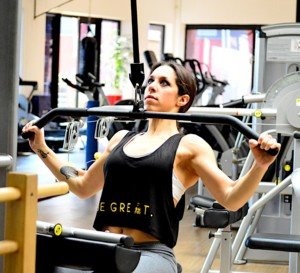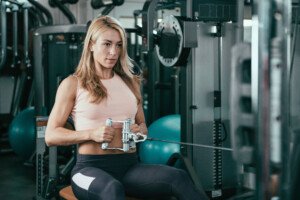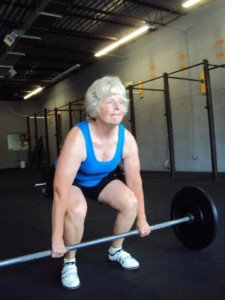
Many senior age men and women do back and arm strength training wrong.
As a fitness expert, I like to point out that old age is never an excuse for poor form.
Bad form, regardless of your age, interferes with your goals, wastes your time and can lead to injury.
Lat Pull-Down Common Mistake Among Older People
• Many seniors and older people love the lat pull-down, and many do it wrong, too. The correct way looks like this:

• This is a great exercise for the back, and it also works the arms.
• Keep your forearms as vertical as possible throughout the routine.
• Many elderly and older women bend their forearms to nearly horizontal at the bottom of the pull. If you’re able to do this, the weight is set entirely too light.
• Furthermore, this strange movement subtracts resistance from the very back muscles that you aim to work.
• The weight should be heavy enough to prevent the ability to stray the forearms from vertical.
Another Common Lat Pull-Down Mistake
• This mistake is more common among senior men than women.
• And it’s that of lifting their butt off the seat to pull down the bar.
• Often, the bar is yanked hard in the process.
• These cheat moves can cause injury. But if you feel invincible, keep in mind that cheating de-isolates the back muscles, which are the muscles you want to strength train when doing the lat pull-down.
• The bar should be released (raised) with control while keeping your butt planted on the seat.
• Do not let the bar fly back up. The release is very important for strengthening the back (and arms).
• If you cannot perform this exercise correctly, the weight is too heavy. Lighten it and forget about your ego.
Finally, with this strength training exercise, pull the bar down to just above the chest and keep your head neutral rather than craning it upward.
The lat pull-down is a great strength training exercise for seniors, as it will strengthen the middle and upper back muscles plus the arms.
Seated Cable Row
• At the general pulley station there are benches attached and stacks of weights to be used with those benches: cable rows.
Another version of the cable row is a separate piece of equipment devoted just to rowing.

Shutterstock/Microgen
• Cable rows work the back and arms.
• Keep your back upright or slightly angled back. Don’t angle back too far.
• Do not yank the handles towards you. Be calm and controlled.
• You can use any variety of handle attachments. The further your hands are apart, the more your lat muscles are worked.
• Always use the foot pad, as this will help isolate the back and arm muscles and keep the lower back stabilized.
• If you must lean way back to pull the handles towards your chest, the weight is too heavy.
• Never round or hunch your back. Keep an arch in your lower back and your shoulders relaxed.
• Always release the resistance with control, taking one to three seconds.
Seated Non-Cable Row
Apply the principles above to any kind of rowing equipment.
Do not confuse the aerobic rowing machine with the strength training movement called “rows.”
A strength training “row” is when you’re seated at any kind of equipment and horizontally (or almost horizontally, depending on the equipment) pulling the resistance towards your chest.
Gyms often have several varieties of seated non-cable row apparatus. Many of these machines come with multiple options for hand placement.
They all come with a pad to place your chest against. Many seniors don’t keep their chest against this pad.
The chest-to-pad connection is vital for isolating the back and arm muscles. Yes, keeping your chest to the pad will make the move more difficult – because it isolates the back and arm muscles. This is the objective.
The above strength training exercises are great for seniors looking to build strength. But are they the best?
Well, when I was a personal trainer I trained many older people and will tell you that the lat pull-down and row should be staples in a senior’s strength training regimen.
But if I had to choose just ONE strength training exercise for the back and arms, to recommend to elderly people, it’s the deadlift!

Problem is, elderly people with little strength training experience are prone to believing that they’re too old to deadlift.
But if you pick up baskets of laundry, you’re already deadlifting. If you pick up potted plants, pets or other objects off the floor, you’re already deadlifting.
A gym deadlift, however, promotes more stabilization to the movement rather than the haphazard movements of house and yard work.
It also allows you to progress with heavier resistance. Lifting loads of laundry and other objects around the house will not provide a progressive strength training component for your arms and back.
Another great strength training move for seniors is the kettlebell swing, which engages the back and arm muscles.
 Lorra Garrick is a former personal trainer certified through the American Council on Exercise. At Bally Total Fitness she trained women and men of all ages for fat loss, muscle building, fitness and improved health.
Lorra Garrick is a former personal trainer certified through the American Council on Exercise. At Bally Total Fitness she trained women and men of all ages for fat loss, muscle building, fitness and improved health.
.
Top image: Freepik.com











